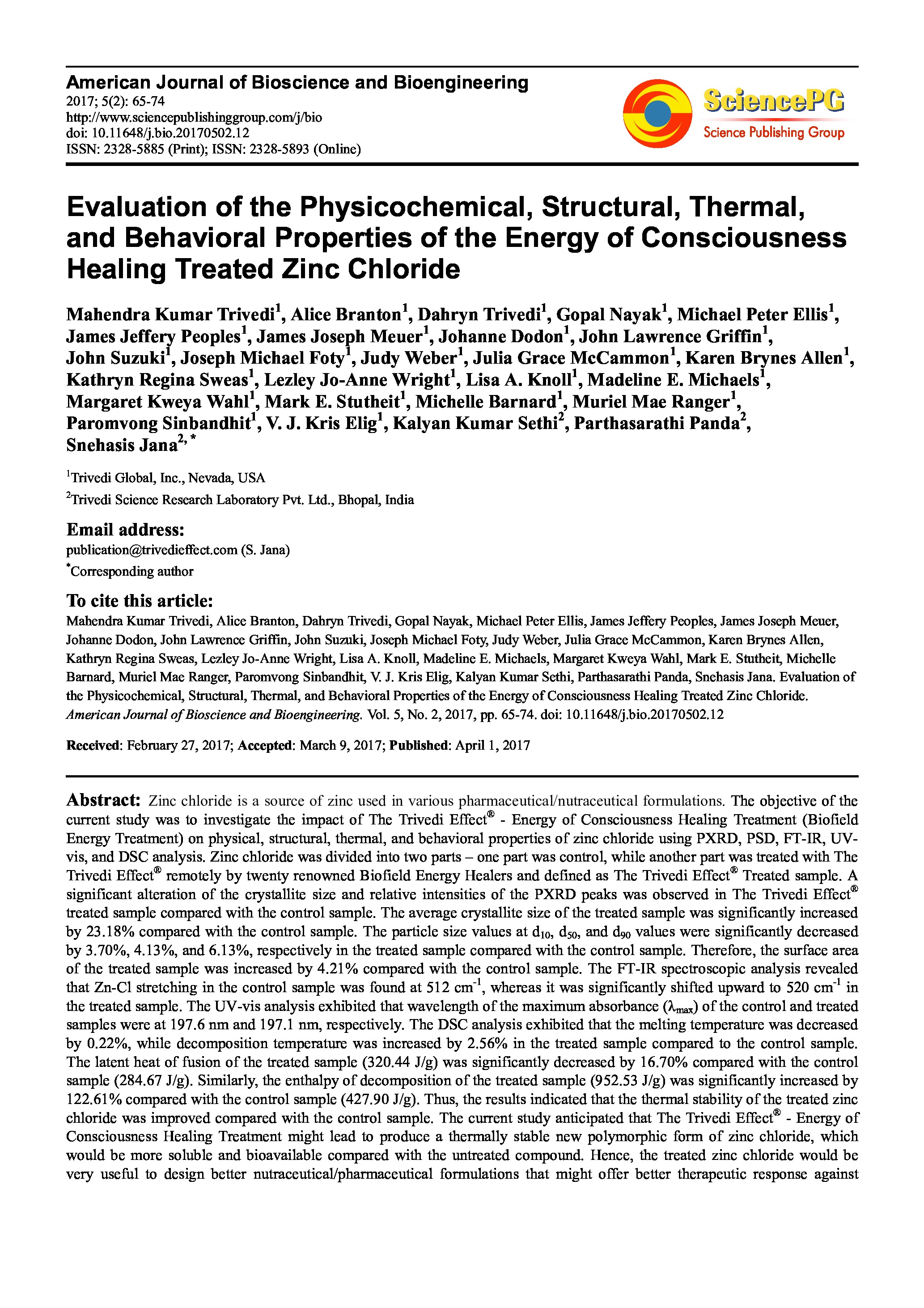Evaluation of the Physicochemical, Structural, Thermal, and Behavioral Properties of the Energy of Consciousness Healing Treated Zinc Chloride
Co-author
Mahendra Kumar Trivedi, Dahryn Trivedi, Gopal Nayak, Michael Peter Ellis, James Jeffery Peoples, James Joseph Meuer, Johanne Dodon, John Lawrence Griffin, John Suzuki, Joseph Michael Foty, Judy Weber, Julia Grace McCammon, Karen Brynes Allen, Kathryn Regina Sweas, Lezley Jo-Anne Wright, Lisa A. Knoll, Madeline E. Michaels, Margaret Kweya Wahl, Mark E. Stutheit, Michelle Barnard, Muriel Mae Ranger, Paromvong Sinbandhit, V. J. Kris Elig, Kalyan Kumar Sethi, Parthasarathi Panda, Snehasis Jana
Affiliation
Trivedi Global Inc.; Trivedi Science Research Laboratory Pvt. Ltd.
Main category
Natural Sciences (Analytical Chemistry, Method Development (Chemistr)
Abstract
Zinc chloride is a source of zinc used in various pharmaceutical/nutraceutical formulations. The objective of the current study was to investigate the impact of The Trivedi Effect® - Energy of Consciousness Healing Treatment (Biofield Energy Treatment) on physical, structural, thermal, and behavioral properties of zinc chloride using PXRD, PSD, FT-IR, UV-vis, and DSC analysis. Zinc chloride was divided into two parts – one part was control, while another part was treated with The Trivedi Effect® remotely by twenty renowned Biofield Energy Healers and defined as The Trivedi Effect® Treated sample. A significant alteration of the crystallite size and relative intensities of the PXRD peaks was observed in The Trivedi Effect® treated sample compared with the control sample. The average crystallite size of the treated sample was significantly increased by 23.18% compared with the control sample. The particle size values at d10, d50, and d90 values were significantly decreased by 3.70%, 4.13%, and 6.13%, respectively in the treated sample compared with the control sample. Therefore, the surface area of the treated sample was increased by 4.21% compared with the control sample. The FT-IR spectroscopic analysis revealed that Zn-Cl stretching in the control sample was found at 512 cm-1, whereas it was significantly shifted upward to 520 cm-1 in the treated sample. The UV-vis analysis exhibited that wavelength of the maximum absorbance (λmax) of the control and treated samples were at 197.6 nm and 197.1 nm, respectively. The DSC analysis exhibited that the melting temperature was decreased by 0.22%, while decomposition temperature was increased by 2.56% in the treated sample compared to the control sample. The latent heat of fusion of the treated sample (320.44 J/g) was significantly decreased by 16.70% compared with the control sample (284.67 J/g). Similarly, the enthalpy of decomposition of the treated sample (952.53 J/g) was significantly increased by 122.61% compared with the control sample (427.90 J/g). Thus, the results indicated that the thermal stability of the treated zinc chloride was improved compared with the control sample. The current study anticipated that The Trivedi Effect® - Energy of Consciousness Healing Treatment might lead to produce a thermally stable new polymorphic form of zinc chloride, which would be more soluble and bioavailable compared with the untreated compound. Hence, the treated zinc chloride would be very useful to design better nutraceutical/pharmaceutical formulations that might offer better therapeutic response against inflammatory diseases, immunological disorders, aging, stress, cancer, etc.
Do you have problems viewing the pdf-file? Download paper
here
If the paper contains inappropriate content, please
report the paper. You will be redirected to the landing page.
